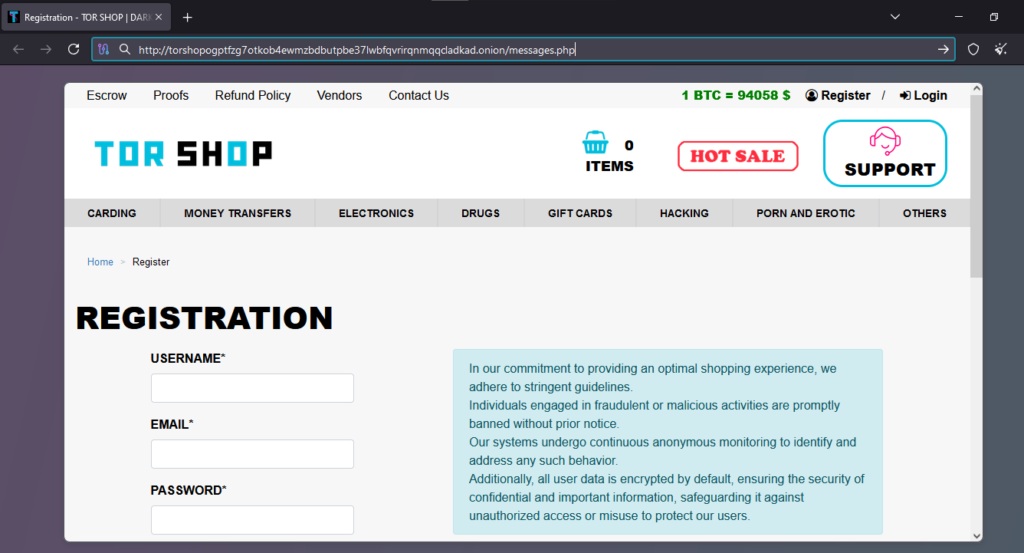Table of Contents
ToggleTorShop – TOR Scam Report (12)
Onion Link : http://torshopogptfzg7otkob4ewmzbdbutpbe37lwbfqvrirqnmqqcladkad.onion/messages.php
Scam Report Date : 2024-11-24
Client Scam Report Breakdown
Original Scam Report :
This client report indicates the victim’s suspicion regarding an ongoing transaction or communication with a seller or service provider. The victim’s concern stems from the response they received, which was overly vague and unhelpful. The phrase “buy and after let we know about that” suggests that the seller or platform is asking the victim to make a purchase first before providing further details or clarifying the service, which raised red flags for the victim. This lack of transparency and the unusual request for upfront payment without providing clear information about the product or service is a classic sign of a potential scam. The victim’s conclusion that this situation may be a scam highlights the importance of caution when dealing with transactions that lack clarity or follow standard business practices.
Terminology and Terms Breakdown
1. “Buy and After Let We Know About That”:
This phrase is a significant clue in the scam report. The seller or service provider’s reply, “buy and after let we know about that,” is a vague and non-committal statement. Typically, legitimate businesses provide clear information upfront about a product, service, or transaction, including terms of payment, delivery timelines, and customer expectations. However, the absence of specific details and the suggestion that the buyer should purchase first, with no clear explanation of what happens after the purchase, is indicative of a common scam tactic. Scammers often ask for upfront payments before offering any clarity on what the victim is actually purchasing, which leaves the victim in a vulnerable position. The failure to offer transparency and assurances before the transaction is completed is a red flag, suggesting that the buyer may never receive the goods or services they were led to believe they were purchasing.
2. “I Think Is a Scam”:
The phrase “I think is a scam” reflects the victim’s growing suspicion after receiving an unsatisfactory response from the seller. The term “scam” refers to fraudulent schemes designed to deceive individuals into giving up their money or personal information, often without providing any real product or service in return. This is typically done by misrepresenting goods, services, or business practices, leaving the victim financially disadvantaged. The victim’s conclusion that this situation may be a scam emphasizes the importance of recognizing red flags during online transactions, such as vague communication, unclear terms of service, and demands for upfront payments without sufficient information. The victim’s gut feeling of suspicion, while not a definitive conclusion, serves as an important early warning sign that should prompt further caution and investigation.
3. Red Flags in Online Transactions:
In this scam report, the most notable issue is the unclear and non-transparent nature of the transaction. In legitimate transactions, businesses provide detailed descriptions of what is being sold, including pricing, delivery terms, and customer support information. Scammers, on the other hand, often employ vague or confusing responses, such as the one mentioned in the report, to keep the buyer in the dark until they have already committed financially. The lack of follow-up details or a clear explanation of the process after the purchase is a common tactic used to catch victims off guard. This vagueness is a classic indicator that the seller may not be trustworthy, and the victim’s instinct to suspect a scam is an important response to these red flags.
Conclusion
The report provides a snapshot of a situation in which the victim’s intuition led them to suspect that they were being targeted by a scam. The lack of clarity from the seller, as well as the ambiguous instructions to “buy and after let we know about that,” is a key indicator that the transaction might not be legitimate. This scenario is a reminder of the importance of transparency in online transactions, where legitimate businesses provide clear and detailed communication to reassure customers.
In addition, the victim’s suspicion that the situation could be a scam underscores the need for vigilance when engaging in online transactions, especially those that lack clear and informative communication. The use of red flags, such as vague responses, demands for upfront payments, and a lack of follow-up clarity, should prompt potential buyers to pause and assess the situation before proceeding further. This type of scam often preys on individuals’ desire for quick transactions or deals, but being cautious and asking for more details can help protect against fraud. In this case, the victim wisely recognized the signs of a scam and took steps to report their concerns before making a potentially costly mistake.







